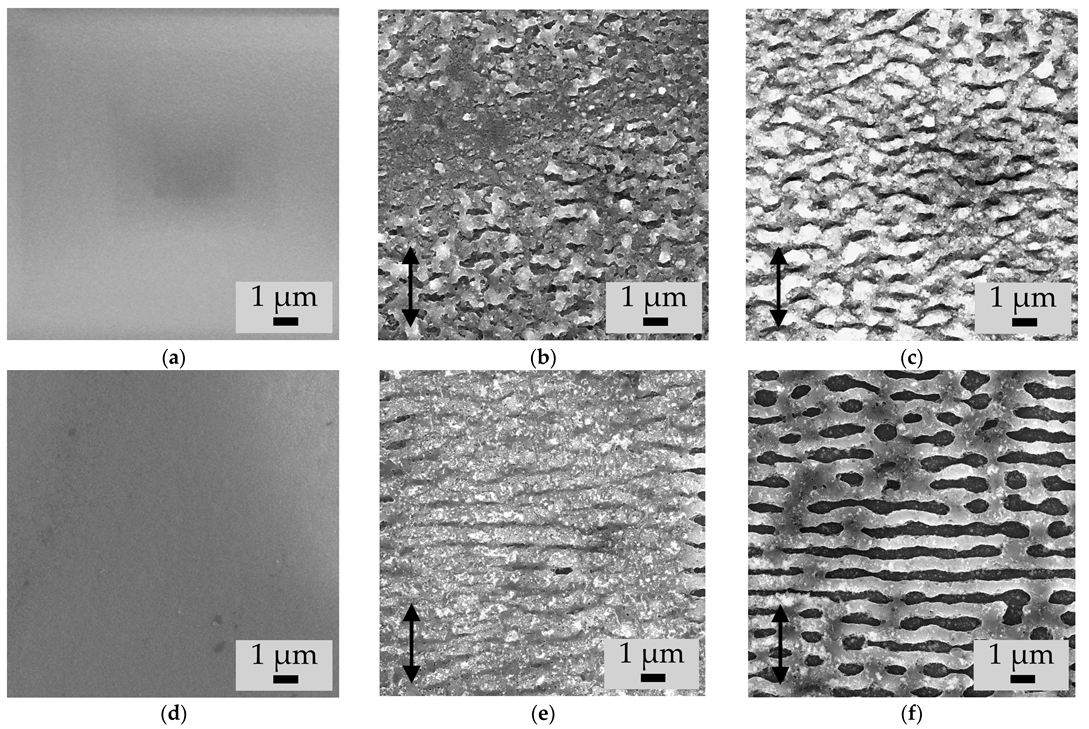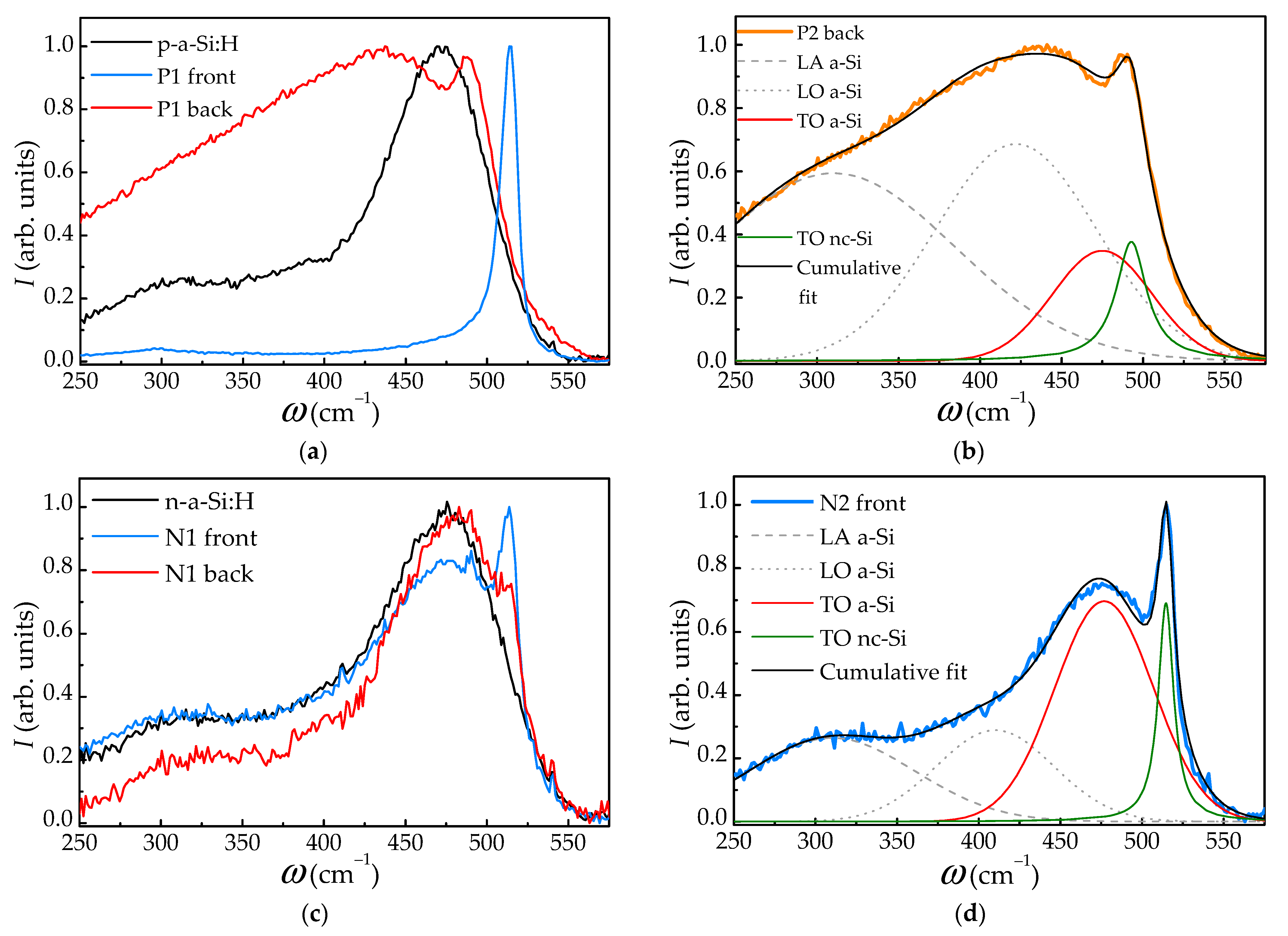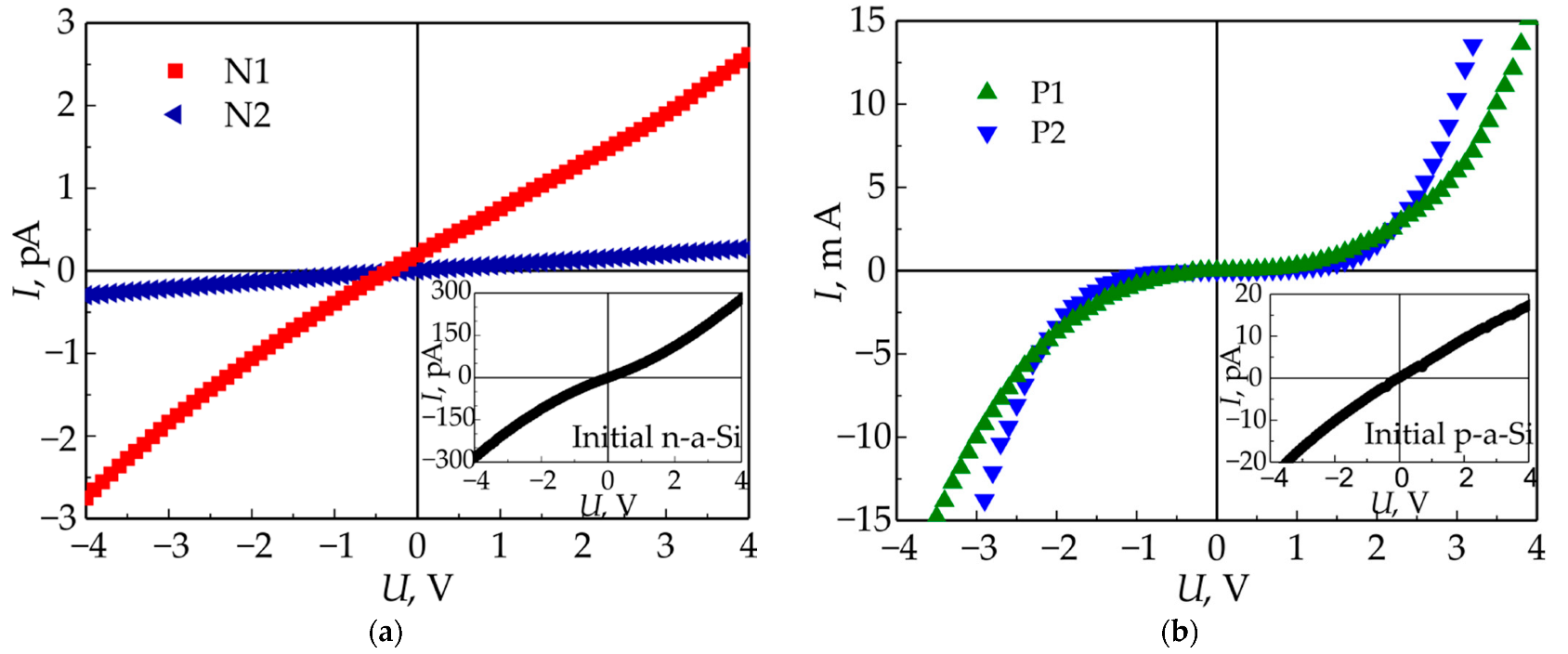Femtosecond Laser Fabrication of Anisotropic Structures in Phosphorus- and Boron-Doped Amorphous Silicon Films
Abstract
1. Introduction
2. Materials and Methods
3. Results
3.1. Surface Periodic Relief Period and Depth
3.2. Raman Spectra Analysis
3.3. Electrical Properties
4. Discussion
4.1. Surface Periodic Structures Formation and Nanocrystallization of Irradiated Films
4.2. Influence of the Structural Changes on the Electrical Properties of Irradiated Films
5. Conclusions
Supplementary Materials
Author Contributions
Funding
Institutional Review Board Statement
Informed Consent Statement
Data Availability Statement
Acknowledgments
Conflicts of Interest
References
- Bonse, J.; Rosenfeld, A.; Krüger, J. On the role of surface plasmon polaritons in the formation of laser-induced periodic surface structures upon irradiation of silicon by femtosecond-laser pulses. J Appl. Phys. 2009, 106, 104910-1–104910-5. [Google Scholar] [CrossRef]
- Bonse, J.; Krüger, J. Pulse number dependence of laser-induced periodic surface structures for femtosecond laser irradiation of silicon. J Appl. Phys. 2010, 108, 034903-1–034903-5. [Google Scholar] [CrossRef]
- Shuleiko, D.V.; Potemkin, F.V.; Romanov, I.A.; Parhomenko, I.N.; Pavlikov, A.V.; Presnov, D.E.; Zabotnov, S.V.; Kazanskii, A.G.; Kashkarov, P.K. Femtosecond laser pulse modification of amorphous silicon films: Control of surface anisotropy. Laser Phys. Lett. 2018, 15, 056001-1–056001-8. [Google Scholar] [CrossRef]
- Shuleiko, D.; Martyshov, M.; Amasev, D.; Presnov, D.; Zabotnov, S.; Golovan, L.; Kazanskii, A.; Kashkarov, P. Fabricating femtosecond laser-induced periodic surface structures with electrophysical anisotropy on amorphous silicon. Nanomaterials 2021, 11, 42. [Google Scholar] [CrossRef] [PubMed]
- Zabotnov, S.; Kolchin, A.; Shuleiko, D.; Presnov, D.; Kaminskaya, T.; Lazarenko, P.; Glukhenkaya, V.; Kunkel, T.; Kozyukhin, S.; Kashkarov, P. Periodic relief fabrication and reversible phase transitions in amorphous Ge2Sb2Te5 thin films upon multi-pulse femtosecond irradiation. Micro 2022, 2, 88–99. [Google Scholar] [CrossRef]
- Barmina, E.V.; Fotakis, C.; Loukakos, P.A.; Stratakis, E.; Shafeev, G.A. Laser-assisted nanostructuring of silicon in liquid environment. Appl. Phys. A 2014, 117, 359–364. [Google Scholar] [CrossRef]
- Kirichenko, N.A.; Barmina, E.V.; Shafeev, G.A. Theoretical and experimental investigation of the formation of high spatial frequency periodic structures on metal surfaces irradiated by ultrashort laser pulses. Phys. Wave Phenom. 2018, 26, 264–273. [Google Scholar] [CrossRef]
- Zhang, Y.; Cheng, K.; Cao, K.; Jiang, Q.; Chen, T.; Zhang, S.; Feng, D.; Sun, Z.; Jia, T. Periodic subwavelength ripples on a Si surface induced by a single temporally shaped femtosecond laser pulse: Enhanced periodic energy deposition and reduced residual thermal effect. J. Phys. D Appl. Phys. 2021, 54, 385106-1–385106-10. [Google Scholar] [CrossRef]
- Miyaji, G.; Miyazaki, K. Fabrication of 50-nm period gratings on GaN in air through plasmonic near-field ablation induced by ultraviolet femtosecond laser pulses. Opt. Express 2016, 24, 4648–4653. [Google Scholar] [CrossRef]
- Borowiec, A.; Haugen, H.K. Subwavelength ripple formation on the surfaces of compound semiconductors irradiated with femtosecond laser pulses. Appl. Phys. Lett. 2003, 82, 4462–4464. [Google Scholar] [CrossRef]
- Le Harzic, R.; Dörr, D.; Sauer, D.; Neumeier, M.; Epple, M.; Zimmermann, H.; Stracke, F. Large-area, uniform, high-spatial-frequency ripples generated on silicon using a nanojoule-femtosecond laser at high repetition rate. Opt. Lett. 2011, 36, 229–231. [Google Scholar] [CrossRef] [PubMed]
- Allahyari, E.; Nivas, J.J.; Skoulas, E.; Bruzzese, R.; Tsibidis, G.D.; Stratakis, E.; Amoruso, S. On the formation and features of the supra-wavelength grooves generated during femtosecond laser surface structuring of silicon. Appl. Surf. Sci. 2020, 528, 146607. [Google Scholar] [CrossRef]
- Zhang, D.; Liu, R.; Li, Z. Irregular LIPSS produced on metals by single linearly polarized femtosecond laser. Int. J. Extrem. Manuf. 2022, 4, 015102. [Google Scholar] [CrossRef]
- Han, W.; Liu, F.; Yuan, Y.; Li, X.; Wang, Q.; Wang, S.; Jiang, L. Femtosecond laser induced concentric semi-circular periodic surface structures on silicon based on the quasi-plasmonic annular nanostructure. Nanotechnology 2018, 29, 305301. [Google Scholar] [CrossRef] [PubMed]
- Nivas, J.J.J.; He, S.; Song, Z.; Rubano, A.; Vecchione, A.; Paparo, D.; Marrucci, L.; Bruzzese, R.; Amoruso, S. Femtosecond laser surface structuring of silicon with Gaussian and optical vortex beams. Appl. Surf. Sci. 2017, 418, 565–571. [Google Scholar] [CrossRef]
- Zhang, D.; Li, X.; Fu, Y.; Yao, Q.; Li, Z.; Sugioka, K. Liquid vortexes and flows induced by femtosecond laser ablation in liquid governing formation of circular and crisscross LIPSS. Opto-Electron. Adv. 2022, 5, 210066. [Google Scholar] [CrossRef]
- Zhang, D.; Sugioka, K. Hierarchical microstructures with high spatial frequency laser induced periodic surface structures possessing different orientations created by femtosecond laser ablation of silicon in liquids. Opto-Electron. Adv. 2019, 2, 190002-1–190002-18. [Google Scholar] [CrossRef]
- Dostovalov, A.; Bronnikov, K.; Korolkov, V.; Babin, S.; Mitsai, E.; Mironenko, A.; Tutov, M.; Zhang, D.; Sugioka, K.; Maksimovic, J.; et al. Hierarchical anti-reflective laser-induced periodic surface structures (LIPSSs) on amorphous Si films for sensing applications. Nanoscale 2020, 12, 13431–13441. [Google Scholar] [CrossRef]
- Yu, X.; Qi, D.; Wang, H.; Zhang, Y.; Wang, L.; Zhang, Z.; Dai, S.; Shen, X.; Zhang, P.; Xu, Y. In situ and ex-situ physical scenario of the femtosecond laser-induced periodic surface structures. Opt. Express 2019, 27, 10087–10096. [Google Scholar] [CrossRef]
- Messaddeq, S.H.; Dumont, A.; Douaud, A.; El-Amraoui, M.; Messaddeq, Y. Formation of cross-superposed LIPSSs on bulk chalcogenide glasses using fs-laser. Adv. Opt. Techn. 2018, 7, 311–319. [Google Scholar] [CrossRef]
- Varlamova, O.; Reif, J. Evolution of femtosecond laser induced surface structures at low number of pulses near the ablation threshold. J. Laser Micro/Nanoeng. 2013, 8, 300–303. [Google Scholar] [CrossRef][Green Version]
- Bonse, J.; Gräf, S. Maxwell meets Marangoni–A review of theories on laser-induced periodic surface structures. Laser Photonics Rev. 2020, 14, 2000215. [Google Scholar] [CrossRef]
- Sipe, J.E.; Young, J.F.; Preston, J.; Van Driel, H.M. Laser-induced periodic surface structure. I. Theory. Phys. Rev. B 1983, 27, 1141–1154. [Google Scholar] [CrossRef]
- Huang, M.; Zhao, F.; Cheng, Y.; Xu, N.; Xu, Z. Origin of laser-induced near-subwavelength ripples: Interference between surface plasmons and incident laser. ACS Nano 2009, 3, 4062–4070. [Google Scholar] [CrossRef]
- Hou, S.; Huo, Y.; Xiong, P.; Zhang, Y.; Zhang, S.; Jia, T.; Sun, Z.; Qiu, J.; Xu, Z. Formation of long- and short-periodic nanoripples on stainless steel irradiated by femtosecond laser pulses. J. Phys. D Appl. Phys. 2011, 44, 505401. [Google Scholar] [CrossRef]
- Yu, X.; Zhang, Q.; Qi, D.; Tang, S.; Dai, S.; Zhang, P.; Xu, Y.; Shen, X. Femtosecond laser-induced large area of periodic structures on chalcogenide glass via twice laser direct-writing scanning process. Opt. Las. Technol. 2020, 124, 105977. [Google Scholar] [CrossRef]
- Tsibidis, G.D.; Fotakis, C.; Stratakis, E. From ripples to spikes: A hydrodynamical mechanism to interpret femtosecond laser-induced self-assembled structures. Phys. Rev. B 2015, 92, 041405. [Google Scholar] [CrossRef]
- Drevinskas, R.; Beresna, M.; Gecevičius, M.; Khenkin, M.; Kazanskii, A.G.; Matulaitienė, I.; Niaura, G.; Konkov, O.I.; Terukov, E.I.; Svirko, Y.P.; et al. Giant birefringence and dichroism induced by ultrafast laser pulses in hydrogenated amorphous silicon. Appl. Phys. Lett. 2015, 106, 17110-1–17110-5. [Google Scholar] [CrossRef]
- Kolchin, A.; Shuleiko, D.; Martyshov, M.; Efimova, A.; Golovan, L.; Presnov, D.; Kunkel, T.; Glukhenkaya, V.; Lazarenko, P.; Kashkarov, P.; et al. Artificial anisotropy in Ge2Sb2Te5 thin films after femtosecond laser irradiation. Materials 2022, 15, 3499. [Google Scholar] [CrossRef]
- Differt, D.; Soleymanzadeh, B.; Lükermann, F.; Strüber, C.; Pfeiffer, W.; Stiebig, H. Enhanced light absorption in nanotextured amorphous thin-film silicon caused by femtosecond-laser materials processing. Sol. Energy Mater. Sol. Cells 2015, 135, 72–77. [Google Scholar] [CrossRef]
- Barmina, E.V.; Shafeev, G.A. Solar cells based on laser-modified silicon. Phys. Wave Phenom. 2018, 26, 93–98. [Google Scholar] [CrossRef]
- Pavlikov, A.V.; Forsh, P.A.; Svyakhovskiy, S.E.; Matsukatova, A.N.; Forsh, E.A.; Kazanskii, A.G.; Kashkarov, P.K. Giant enhancement of free charge carrier concentration in boron-doped amorphous hydrogenated silicon under femtosecond laser crystallization. Appl. Phys. Lett. 2018, 113, 203103-1–203103-5. [Google Scholar] [CrossRef]
- Zhan, X.-P.; Hou, M.-Y.; Ma, F.-S.; Su, Y.; Chen, J.-Z.; Xu, H.-L. Room temperature crystallization of amorphous silicon film by ultrashort femtosecond laser pulses. Opt. Laser Technol. 2019, 112, 363–367. [Google Scholar] [CrossRef]
- Kudryashov, S.I.; Danilov, P.A.; Porfirev, A.P.; Rudenko, A.A.; Melnik, N.N.; Kuchmizhak, A.A.; Vitrik, O.B.; Ionin, A.A. Optical and structural phenomena at multipulse interference femtosecond laser fabrication of metasurfaces on a thin film of amorphous silicon. JETP Letters 2019, 110, 755–759. [Google Scholar] [CrossRef]
- Gesuele, F.; Nivas, J.J.; Fittipaldi, R.; Altucci, C.; Bruzzese, R.; Maddalena, P.; Amoruso, S. Analysis of nascent silicon phase-change gratings induced by femtosecond laser irradiation in vacuum. Sci. Rep. 2018, 8, 12498-1–12498-10. [Google Scholar] [CrossRef]
- Ambrosone, G.; Coscia, U.; Lettieri, S.; Maddalena, P.; Minarini, C. Optical, structural, and electrical properties of μc-Si:H films deposited by SiH4+H2. Mater. Sci. Eng. B 2003, 101, 236–241. [Google Scholar] [CrossRef]
- Choi, T.Y.; Hwang, D.J.; Grigoropoulos, C.P. Ultrafast laser-induced crystallization of amorphous silicon films. Opt. Eng. 2003, 42, 3383–3388. [Google Scholar]
- Terekhov, V.A.; Terukov, E.I.; Undalov, Y.K.; Barkov, K.A.; Seredin, P.V.; Goloshchapov, D.L.; Minakov, D.A.; Popova, E.V.; Zanin, I.E.; Serbin, O.V.; et al. Rearrangement of the optical properties of a-SiOx: H films after crystallization of silicon nanoclusters. J. Non-Cryst. Solids. 2021, 59–60, 121053-1–121053-9. [Google Scholar] [CrossRef]
- Bermejo, D.; Cardona, M. Raman scattering in pure and hydrogenated amorphous germanium and silicon. J. Non-Cryst. Solids. 1979, 32, 405–419. [Google Scholar] [CrossRef]
- Campbell, I.H.; Fauchet, P.M. The effects of microcrystal size and shape on the one phonon Raman spectra of crystalline semiconductors. Solid State Commun. 1986, 58, 739–741. [Google Scholar] [CrossRef]
- Volodin, V.A.; Kachko, A.S.; Cherkov, A.G.; Latyshev, A.V.; Koch, J.; Chichkov, B. Femtosecond pulse crystallization of thin amorphous hydrogenated films on glass substrates using near ultraviolet laser radiation. JETP Lett. 2011, 93, 603–606. [Google Scholar] [CrossRef]
- Bustarret, E.; Hachicha, M.A.; Brunel, M. Experimental determination of the nanocrystalline volume fraction in silicon thin films from Raman spectroscopy. Appl. Phys. Lett. 1988, 52, 1675–1677. [Google Scholar] [CrossRef]
- Martsinovskii, G.A.; Shandybina, G.D.; Smirnov, D.S.; Zabotnov, S.V.; Golovan’, L.A.; Timoshenko, V.Y.; Kashkarov, P.K. Ultrashort excitations of surface polaritons and waveguide modes in semiconductors. Opt. Spectrosc. 2008, 105, 67–72. [Google Scholar] [CrossRef]
- Bonse, J.; Rosenfeld, A.; Krüger, J. Femtosecond laser-induced periodic surface structures: Recent approaches to explain their sub-wavelength periodicities. Proc. SPIE 2011, 7994, 79940M. [Google Scholar] [CrossRef]
- Guk, I.V.; Shandybina, G.D.; Yakovlev, E.B. Role of the heat accumulation effect in the multipulse modes of the femtosecond laser microstructuring of silicon. Semiconductors 2016, 50, 694–698. [Google Scholar] [CrossRef]
- Martsinovsky, G.A.; Shandybina, G.D.; Dement’eva, Y.S.; Dyukin, R.V.; Zabotnov, S.V.; Golovan’, L.A.; Kashkarov, P.K. Generation of surface electromagnetic waves in semiconductors under the action of femtosecond laser pulses. Semiconductors 2009, 43, 1298–1304. [Google Scholar] [CrossRef]
- Street, R.A.; Kakalios, J.; Hack, M. Electron drift mobility in doped amorphous silicon. Phys. Rev. B 1988, 38, 5603–5609. [Google Scholar] [CrossRef] [PubMed]
- Hoheisel, M.; Fuhs, W. Drift mobility in n– and p–conducting a-Si:H. Philos. Mag. B 1988, 57, 411–419. [Google Scholar] [CrossRef]
- Street, R.A.; Zesch, J. Time-of-flight photoconductivity in a-Si:H. J. Non-Cryst. Solids. 1983, 59–60, 449–452. [Google Scholar] [CrossRef]
- Agarwal, S.C. Influence of heterogeneities on the electronic properties of hydrogenated amorphous silicon. Philos. Mag. 2014, 94, 1642–1660. [Google Scholar] [CrossRef]
- Arzhannikova, S.A.; Efremov, M.D.; Kamaev, G.N.; Vishnyakov, A.V.; Volodin, V.A. Special features of the electrical conductivity in doped α-Si:H films with silicon nanocrystals. Semiconductors 2005, 39, 448–454. [Google Scholar] [CrossRef]
- Karpov, V.G. Electric field driven optical recording. Appl. Phys. Lett. 2010, 97, 033505-1–033505-3. [Google Scholar] [CrossRef]







| Sample | Doping Type | Thickness (μm) | Fluence (J/cm2) | Scanning Speed V (μm/s) | Laser Pulses Number N | LIPSS Period (μm) |
|---|---|---|---|---|---|---|
| P1 | p-a-Si | 1.25 ± 0.03 | 0.3 ± 0.1 | 200 | 30 | 1.1 ± 0.1 |
| P2 | 50 | 120 | 0.84 ± 0.07 | |||
| N1 | n-a-Si | 0.35 ± 0.04 | 0.15 ± 0.05 | 200 | 30 | 1.06 ± 0.03 |
| N2 | 50 | 120 | 0.98 ± 0.01 |
| Sample | Nanocrystal Size dnc-Si (nm) | Nc-Si Phase Volume Fraction fC (%) | ||
|---|---|---|---|---|
| Front | Back | Front | Back | |
| P1 | 5 ± 2 | 1.0 ± 0.5 | 79 ± 13 | 41 ± 6 |
| P2 | 5 ± 2 | 1.0 ± 0.5 | 84 ± 7 | 42 ± 5 |
| N1 | 3 ± 1 | 3 ± 1 | 18 ± 3 | 7 ± 3 |
| N2 | 4 ± 1 | 3 ± 1 | 19 ± 2 | 11 ± 5 |
| Sample | E ∥ LIPSS | E ⊥ LIPSS | ||
|---|---|---|---|---|
| Area | Dark Conductivity (S/cm) | Area | Dark Conductivity (S/cm) | |
| P1 | P1–1 | (12.5 ± 0.6) × 10−3 | P1–2 | (3.5 ± 0.9) × 10−3 |
| P2 | P2–1 | (11 ± 5) × 10−3 | P2–2 | (2.1 ± 1.3) × 10−3 |
| Unmodified p-a-Si | (2.2 ± 0.5) × 10−9 | |||
| N1 | N1–1 | (11 ± 5) × 10−5 | N1–2 | (8.3 ± 0.4) × 10−6 |
| N2 | N2–1 | (8.1 ± 0.7) × 10−6 | N2–2 | (8.6 ± 0.1) × 10−7 |
| Unmodified n-a-Si | (1.9 ± 0.5) × 10−6 | |||
Publisher’s Note: MDPI stays neutral with regard to jurisdictional claims in published maps and institutional affiliations. |
© 2022 by the authors. Licensee MDPI, Basel, Switzerland. This article is an open access article distributed under the terms and conditions of the Creative Commons Attribution (CC BY) license (https://creativecommons.org/licenses/by/4.0/).
Share and Cite
Shuleiko, D.; Zabotnov, S.; Martyshov, M.; Amasev, D.; Presnov, D.; Nesterov, V.; Golovan, L.; Kashkarov, P. Femtosecond Laser Fabrication of Anisotropic Structures in Phosphorus- and Boron-Doped Amorphous Silicon Films. Materials 2022, 15, 7612. https://doi.org/10.3390/ma15217612
Shuleiko D, Zabotnov S, Martyshov M, Amasev D, Presnov D, Nesterov V, Golovan L, Kashkarov P. Femtosecond Laser Fabrication of Anisotropic Structures in Phosphorus- and Boron-Doped Amorphous Silicon Films. Materials. 2022; 15(21):7612. https://doi.org/10.3390/ma15217612
Chicago/Turabian StyleShuleiko, Dmitrii, Stanislav Zabotnov, Mikhail Martyshov, Dmitrii Amasev, Denis Presnov, Vyacheslav Nesterov, Leonid Golovan, and Pavel Kashkarov. 2022. "Femtosecond Laser Fabrication of Anisotropic Structures in Phosphorus- and Boron-Doped Amorphous Silicon Films" Materials 15, no. 21: 7612. https://doi.org/10.3390/ma15217612
APA StyleShuleiko, D., Zabotnov, S., Martyshov, M., Amasev, D., Presnov, D., Nesterov, V., Golovan, L., & Kashkarov, P. (2022). Femtosecond Laser Fabrication of Anisotropic Structures in Phosphorus- and Boron-Doped Amorphous Silicon Films. Materials, 15(21), 7612. https://doi.org/10.3390/ma15217612











